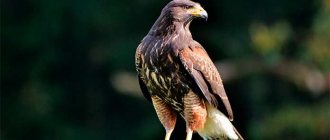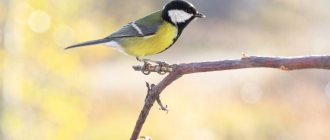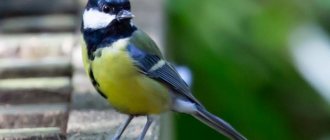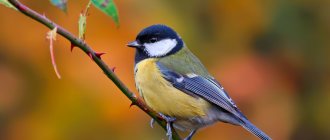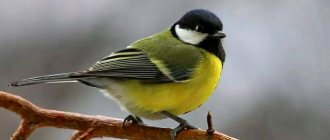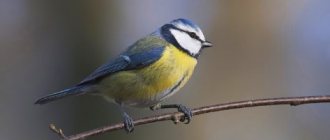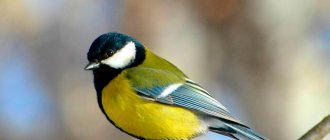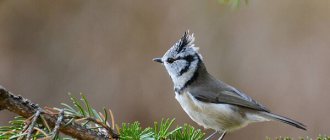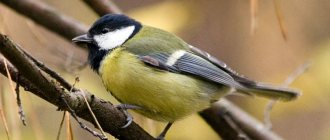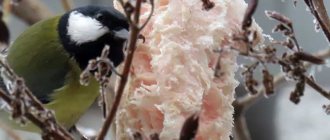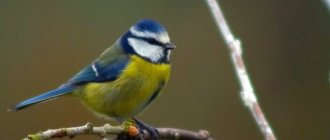On this page I have collected photos of birds similar to tits. For what? It often happens that a bird has settled on the site, sings in the morning, pleases with its singing, but what its name is “only God knows.” So we come up with our own nicknames for them, and even more often we saw the blue color in the plumage and called them titmice, but in fact, only a few titmice have blue in their color.
Tit and Robin
Perhaps it will be useful for someone to determine the name of their favorite feathered friend. And so - there are many birds similar to tits, here are photographs of some of them.
What does it look like
The long-tailed tit, or tit, is a member of a separate family of the same name. The body weight is 8-9 g, but the bird looks much more voluminous due to its fluffy and very loose plumage. For comparison, the mass of a sparrow is 24-40 g. Even the presence of voluminous plumage does not hide its small dimensions. Obviously, the long-tailed tit is one of the smallest birds on Earth, and especially considering the fauna of Eurasia, it stands out for its miniature size.
The color of the body is light pink, the head is white, the long tail and the ends of the wings are black. This pattern is an excellent camouflage, as it blends in with the tree bark.
It’s funny, but it’s not for nothing that the name “polovnik” resembles a kitchen appliance. From the side, the black outline of the tail and pink belly really resemble a ladle.
Photo of the ladle
Family of long-tailed tits - representatives
It is typical for birds to gather in flocks, calling to each other with constant regularity, emitting a characteristic crackling chirp. In this, different members of the family are very similar.
Some subspecies from today's list of the family of long-tailed tits were classified as other families. The diversity of this breed is facilitated by the fact that some species and subspecies can produce hybrids with other representatives from the list.
Tit photo
Externally, long-tailed tits differ slightly. The Pyrenean species does not have black stripes on the back, while the Balkan species is very small in size. It is worth saying that the list of species of long-tailed tits has undergone a number of changes. Thus, one species of birds from the Caucasian forests was removed from the list; other species, on the contrary, were included from other families. This is due in part to improvements in modern methods of studying genetics. The press publishes characteristic nucleotide sequences found in the DNA molecule of these passerines.
Long-tailed tit
Who came first?
In previous years, the symbols of Belarus were the white stork, white wagtail, oriole, house sparrow, city swallow, great gray owl, lapwing, nightingale, great egret, greylag goose, kestrel, great curlew, black swift, hoopoe, cuckoo, long-eared owl, crested lark, goldfinch, greater spotted eagle and capercaillie. 2021 passes under the wings of the nightjar.
And the national campaign “Bird of the Year” has been carried out by the APB since 2000 to attract people’s attention to the wild birds of Belarus, their problems and the need to preserve their habitats.
Reproduction of CityDog.by materials is possible only with the written permission of the editors. Details here.
Photo: Andrey Shevchenko.
What birds are similar to the long-tailed tit?
From the name it is clear that the bird has relatives among tits. Previously, it was classified as a thick-billed tit, but later a separate family was identified for it, and it includes 23 species. Among them are the common, Pyrenees, pink, Balkan and South Japanese long-tailed tits.
The habits of this species of animal are very similar to tits. It is even convenient for them to combine wandering with flocks of tits, great birds and wrens. In winter they migrate to Belarus. The cold does not prevent the babies from searching for mating as early as February. In March, nest construction begins.
Photo of the common tit
Where does the long-tailed tit live?
The feathered baby can be found in Asia or Europe. The long-tailed tit can be found especially often in Siberia, Great Britain, in the north and center of European territory. The extreme point where the polovnik flies is Kamchatka.
The pink long-tailed tit lives in England and France. It produces offspring from other subspecies, and such hybrids are found in Germany and Austria. The South Japanese tit, which lives on the island of Hokaido in Japan, also spreads offspring from other members of the family.
The Pyrenean long-tailed tit can also be found in Italy. It is distinguished by the fact that it does not have black feathers on its back, like the poloved bird.
Ladle on a branch
Character and lifestyle
The blue tit has a cocky temperament, to put it mildly, just like its other tit brothers. They often get into altercations with small birds of other species, winning back their territory. The blue tit shows its quarrelsomeness especially clearly during the mating season, when it drives away even its own kind from the supposed nesting site.
Regarding humans, the blue tit has a friendly attitude, it is very curious, but at the same time cautious. The blue tit (princeling) is uniquely cautious; it is very difficult to track it during the nesting period.
Even for an experienced ornithologist it is considered great luck to find a nest of a princeling, securely hidden among the willows and reeds. In the warm season, the bird leads a secretive lifestyle, but with the arrival of winter, when its light plumage camouflages it against the background of snow, the blue tit becomes much bolder.
Blue tits live sedentary lives, roaming only short distances. Migrations may be caused by deforestation, as well as cold snaps. In search of food, they often fly to city squares and parks, willingly feasting on seeds and lard from feeders, suspended by a caring human hand.
What do tits eat
The basis of insect nutrition is from the bark of trees. The larvae and spiders provide a source of protein, which is a mutual benefit for the tree. Tiny birds inquisitively search a variety of places and crevices, and find pests in hard-to-reach nooks and crannies, in bark detachments and between branches. Considering that the flock numbers several tens of thousands of birds, and all of them regularly need food, the ecological importance of this species is difficult to overestimate.
Polovnik eats
What do nests look like and where do long-tailed tits nest?
The bird prefers to be in flocks until the nesting period. For hatching, it prefers to find dense thickets along the edge of the river. There it is easier for her to hide from predators. Trees and riverine limestones are also suitable for this purpose. Since the end of winter, vapors have been forming; in March, rapid construction is already underway.
It is worth talking separately about the quality of the nest. This is not just a bunch of branches, but a beautiful and durable oval-shaped structure. Both partners actively participate in its construction, devoting a lot of time to laying the material. Moss, lichen, fluff, wool, insect cocoons, feathers and even cobwebs are put to work and laid out in soft layers using tiny beaks. The material and technology allow the bird to perfectly camouflage its shelter; in appearance it blends in with the branches and bark.
The clutch contains from 8 to 12 eggs, very rarely about 5 or 15. They have enough space, since the nest is up to 11 cm wide and up to 16 cm high. The shell is white or yellowish, sometimes with reddish specks. There are barely noticeable gray purple spots on the surface. The egg size is tiny, only 15 mm, width up to 11 mm, weight 1 g. It is surprising that chicks are produced from them. It is curious that in nature food is brought to babies by both parents and other members of the flock who did not manage to leave offspring. Apparently, such collectivism contributes to better survival of the species.
Tit female and male
Appearance
The beak of these birds is short , similar to a cone, slightly rounded at the top and flattened at the sides. The plumage of tits is very beautiful and bright. This bird stands out among all other birds with its yellow belly with a small “tie” on it. A “tie” is a black stripe that stretches from the chest to the tail. The head is decorated with a black cap with an unusual, metallic blue sheen. The cheeks are painted white, approximately the same white-yellow spot is located on the back of the bird’s head. The throat and chest are painted with a pleasant tint of blue, although they are black. The back is green-yellow or gray-blue, with a predominant olive tint.
The variety of shades and colors makes the tit unusually beautiful and especially stands out in winter, against the white background of snow cover.
The small nostrils are covered with inconspicuous bristly feathers. The paws are quite strong, with strong toes and sharp, strongly curved claws. This paw structure helps the tit stay on branches even in strong winds. The wings are rather short and rounded at the end. The tail consists of 12 tails , smooth, sometimes with a slight notch.
Poultry at home, what to keep, what to feed
Like the yellow tit, the long-tailed bird needs space to fly in a cage with many perches. The chicks will leave the nest in two weeks. By this time, space should already be ready for them, or the enclosure should be sufficiently free.
Reproduction in apartment conditions is hampered by the small space of the cage and the lack of necessary building material, mainly moss. However, in a spacious enclosure and with the necessary filling of the bottom, reproduction is possible.
Long-tailed tits on hand
In nature, birds feed on spiders and larvae; like forest orderlies, birds pull insects out of the bark. You obviously can’t find the food you need in your home refrigerator; you’ll have to go to a specialized pet store. They will offer nutritional formulas. For the rehabilitation of sick chicks, or for their better growth, the veterinarian may recommend minced meat.
It is forbidden to pour boiled water into the drinking bowl. It differs in mineral composition and in nature tits drink from the river. There should be constant water in the empty drinking bowl. A small body needs regular nutrition.
Birds with long tails eat
Differences between tits in pairs
Male and female tits have the same color; they differ only in that the older the bird gets, the brighter its plumage. Birds change feathers once a year. For nesting, birds choose large empty hollows that previously served as a home for woodpeckers; simple holes in trees are also suitable for them. When choosing a place for their home, tits will prefer to live where lesser spotted woodpeckers previously lived. Some species, such as the plume tit and tufted tit, can hollow out holes for themselves.
Tits collect building materials for their nests:
- various types of moss;
- animal fur;
- The presence of feathers is no exception.
They use all this in their bedding. Both the male and female collect materials for the nest, but each of them has their own task. Only males collect mosses and lichens, while females collect lighter material (wool, feathers).
